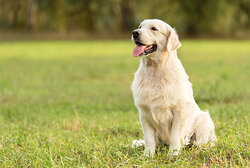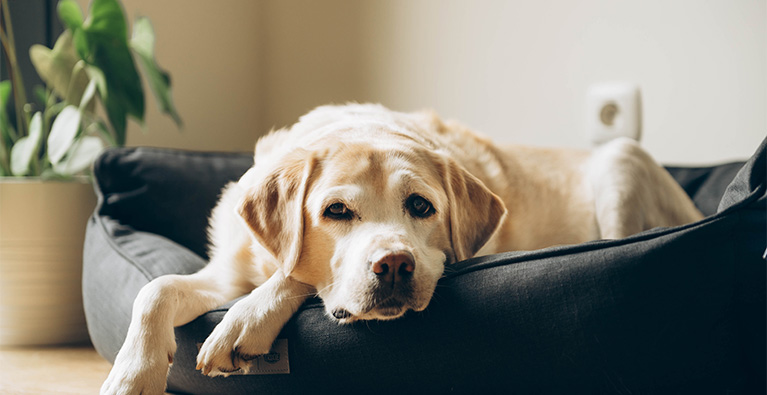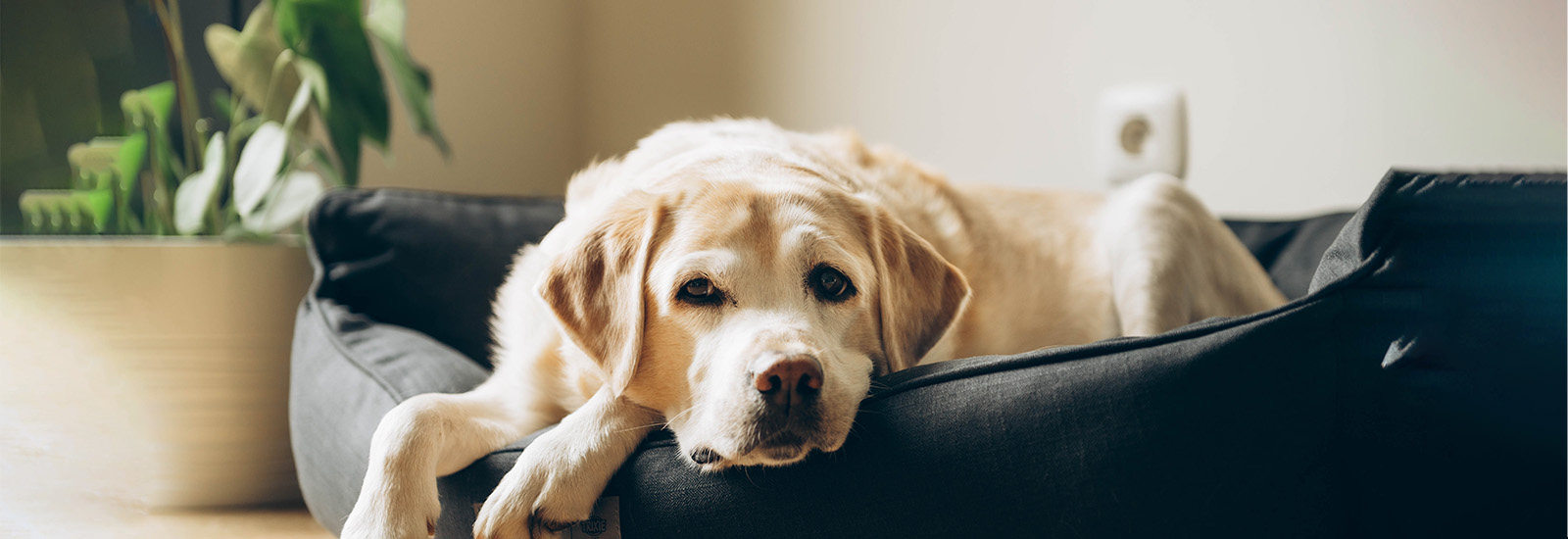Teaching a dog the command “Stay!”
"Stay" is an important command. A dog that responds correctly to this command is a great companion in many everyday situations. The easiest way for a dog to learn it is in the “Down” position with the help of a word command, a visual signal and some tasty treats.
Why is the command “Stay” so important?
If you teach your dog very effectively from the start that it is not allowed to get up from the “Sit” or “Down” position until it receives a release command, for example “OK”, then you may not actually need to use “Stay”. However, practice shows that this is very rarely the case. Most dogs need a little reminder that a particular command is still in place and has to be maintained. “Stay!“ is excellent for this purpose.
The command can be given to the dog while it is standing, sitting or lying down. It is therefore suitable, for example, at home when you want your dog to stay in its basket. The same applies on a train, in a bus, or when visiting a restaurant when you want your dog to sit or lie obediently next to you. It is also ideal before crossing a busy road. With the command “Stay” you are able to tell your four-legged friend to stand still until it receives the release command. These exercises can also be very useful at a dog training ground.
Practising “Stay” with a puppy
Before you start with the command “Stay”, a dog should first have mastered “Sit” and “Down”. After all, you will usually want it to stay in one of these positions. With a puppy, however, you should be more lenient at first and be glad even if it obeys a command for just a few seconds. Puppies and young dogs have a very short span of attention. After a few practice rounds at the latest, they will want to get back to playing, scuffling and running around. Be patient, because this is perfectly normal. It is best to accommodate this by planning several short training sessions throughout the day.
How can I teach my dog to “Stay”?
It is important for a dog to understand what you want it to do. This is why each command should be carried out slowly and broken down into easy-to-understand steps. If your dog does not respond correctly straight away, you should not assume that it is doing this on purpose. Instead, think about how you can make it easier for your pet to understand. For the command “Stay!” it is especially important to increase the length of time very slowly.
For the command “Stay” it is best to proceed as follows:
- Have treats ready
Make sure you have a bag of tasty treats. These will grab the attention of almost any dog. They provide positive reinforcement. As soon as your dog does something right, you should give it a reward. At first, it is enough if your dog has followed a command for just a few seconds, and you were standing right next to it. As you progress further, you should only give your dog treats if the command has been carried out to your full satisfaction. If your pet receives a generous number of treats, then remember to account for this in its daily food allowance.
- The time and the place should fit well together
When your puppy is in a playful mood, when it is time for a walk, or when it has just settled down for a nap, it is not a good time for training. Your dog should have already had the chance to let off steam and be in the mood for activity. For a new command, it is important that there are as few distractions as possible. Your own home or garden is often a good place. If there is too much hustle and bustle here, look for a secluded spot outdoors where your dog will not be distracted by other dogs or even wild animals.
- Start with the command “Down”
You can give the command “Stay!” when a dog is in the “Sit!”, “Down!” or “Stand!” position. To start off with, it is advisable to practise the command “Stay” when your dog is lying down. This is because it is more difficult for a dog to move away from this position. It is not able to simply run away, but has to stand up first, so it is easier to spot and stop this this behaviour than when the dog is sitting or standing. First of all, give your dog the command “Down”. If things are not yet working perfectly, you should first keep practising this command. You will find a detailed guide in our article "Teaching a dog the command “Down”.
- The command “Stay”
As mentioned previously, some dog owners train their dogs very intensively right from the start to understand that a command always remains in effect until the dog has been “released” from it. In this case, you could leave out “Stay!” altogether. It will, however, then often be necessary to repeat the command “Sit!” or “Down!” several times. Many dog owners choose to work with "Stay" to maintain a command. To train your dog to do this, follow these simple steps.
As soon as your dog is lying down, take a step backwards, give the command “Stay!” and combine this with a hand signal, for example holding the palm of your hand out in front of you. Go back to your dog straight away and give it a reward. Finally, release the command, for example with “OK”, and make it clear to your dog that it is now allowed to get up.
After a short while, repeat the commands: First “Down”, and then “Stay”. Ideally, you should get a feel for how long you can keep the command in place before your dog gets up. Shortly before this happens would be the best time to release your dog from the command. This may well be after just a few seconds at first, and you may have to remain no more than a metre away from your pet. This is normal and is certainly no reason to give up.
- Keep practising and slowly increase the requirements
The objective of the command “Stay!” is for a dog to learn to remain in a particular position for an extended period of time, even when the command is given from some distance. Decide for yourself whether you also want to train your dog to do this from the "Sit" position, or whether you would prefer to increase the “Down” requirements first. This can easily be done by requiring your dog to “Stay” for an increasingly long period of time. To make this clear, avoid repeating the word command too often. Instead, keep using your hand signal for the command for as long as possible.
- The longer and more reliably your dog keeps in position, the further you can now move away from your pet. It is very convenient when a dog responds to commands not only when you are standing right next to it, but also when you are a few metres away. Over time, you will also be able to increase the requirements regarding distractions. Practice when other people or dogs are around, hide behind a tree for a few seconds, or give the command before crossing a road.
It is important not to ask too much of your dog too quickly, but to gradually increase the requirements. Regular training is important here.
Video about the commando "Stay"
Would you like to see the use of the command “Stay” on video? Animal trainer Fränzi Lüttich demonstrates how it works with Weimaraner Sky and dachshund Polly:
You may also like this

Teaching your dog the command "Down"
“Down!” is one of the most important commands a dog should master

Teaching your dog to sit
How to teach your dog to sit

Lead training
We show you how you can train to walk properly on a lead

Keeping your dog occupied
Occupation is important for a dog





